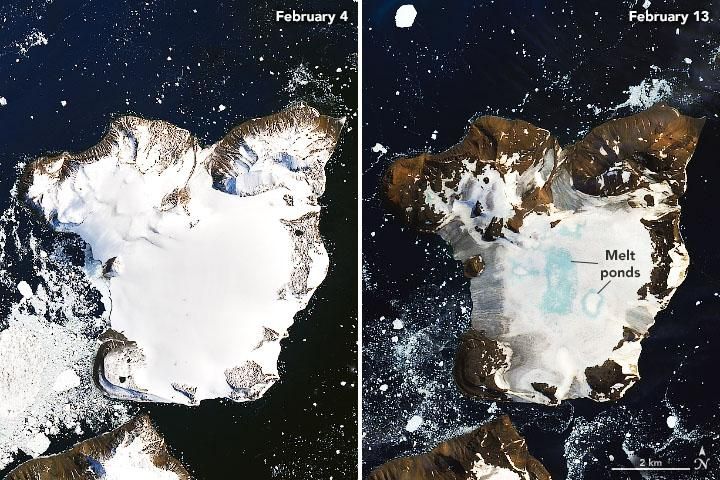Melting Glaciers Reveal a New Island in Antarctica
Earlier this month, Antarctica experienced its third major melt event of the summer, including record high temperatures
/https://tf-cmsv2-smithsonianmag-media.s3.amazonaws.com/filer/93/2c/932c6bab-12e7-4dfd-9249-d7c690592cd4/2020_feb24_nasaglacier.jpg)
High temperatures in Antarctica earlier this month have caused ice caps to melt to an unprecedented degree. As the glaciers retreat, they release pressure on the continent, allowing the ground itself to rise up. Sometimes, this effect stabilizes the ice by anchoring it in place, but rebounding ground could accelerate the glacial breakup by causing more cracks. When the latter happens and a glacier quickly sheds ice as the ground rises up, the land underneath maybe start to appear.
Such is the story of how a never-before-seen island emerged off the coast of Antarctica recently.
Members of the Thwaites Offshore Research (THOR) project first spotted the uncharted island while completing an expedition aboard the Nathaniel B. Palmer research vessel while passing through the Pine Island Bay, reports Nature News’ Giuliana Viglione. The island—named Sif after the goddess of Earth and the wife of thunder god Thor—is big enough for satellites to spot from space but had previously been hidden under ice.
Although experts don’t yet know how long the island has been free from its chilly hiding place, climate change is likely to blame for the reveal, per Nature News.
The Pine Island Glacier is one of the fastest-retreating glaciers in Antarctica because it is shedding ice faster than the glacier is expanding outward. Earlier this month, the glacier purged an iceberg twice the size of Washington, D.C.
Because ships rarely travel as far south as the Palmer did earlier this month, the crew is likely the first to discover the island. University of Houston marine geologist Julia Wellner, one of the lead investigators of the expedition, first shared the discovery on Twitter on February 11, Nature News reports.
After being the first visitors, we can now confirm that Sif Island is made of granite and that it is covered by remnant ice shelf, and a few seals. Photos by CD Hillenbrand (BAS) and Laura Taylor (UH). @glacierthwaites @glacieroffshore @GAViglione #nbp2002 @BAS_News @UHEAS pic.twitter.com/dtWtdI95tL
— Julia Smith Wellner (@houston_wellner) February 23, 2020
The Palmer crew has taken samples from island, which is made of granite, that could provide insight into the way the continent is shifting, but preliminary results from the team won’t be available until late March when the ship returns to port.
“This one island could hold a lot of clues,” University of Virginia in Charlottesville glacial geologist Lauren Simkins tells Nature News.
When Sif was spotted in the southern seas, much of northern Antarctica was experiencing a period of extreme heat. NASA released satellite images showing dramatic melting on the northern tip of the Antarctic Peninsula. The images, taken only nine days apart, show Eagle Island’s northern shore turned bare, and ponds of ice melt forming in the middle of the island.
"We have to understand that those images were taken about as far north in Antarctica as you can get. So if any place is going to have those melt ponds, that's certainly going to be one place,” the National Science Foundation's head of Antarctic sciences Alexandra Isern tells NPR’s Bill Chappell.
Most of the ice melted on February 6, when weather stations measured a record high temperature of 64.9 degrees Fahrenheit. By February 13, 20 percent of Eagle Island’s snow and ice cover was melted.
"These warm events are occurring more frequently," Isern tells NPR. A melting event of this extreme is more common in the Arctic where new islands are discovered rather frequently. The Russian navy, for example, has spotted five in total since October 2019.

Normally, most of Antarctica is protected from rising temperatures by the Southern Hemisphere westerlies, a band of warm air currents that prevents the heat from crossing the Southern Ocean and approaching the South Pole. But earlier this month, the westerlies were in a weakened state, and the extra-tropical winds were able to reach the ice sheet, NASA explains in a statement. The surface temperature of the sea was also a few degrees warmer than usual.
Isern describes the early February melt as a weather event. She says that more research will be necessary to determine whether this was an anomaly of overlapping factors that led to the heat wave, or if this is part of a larger trend.
“If you think about this one event in February, it isn’t that significant,” Nichols College glaciologist Mauri Pelto said in the NASA statement, which points out that this is the third major melt event this summer, following heat waves in November 2019 and January 2020. “It’s more significant that these events are coming more frequently.”